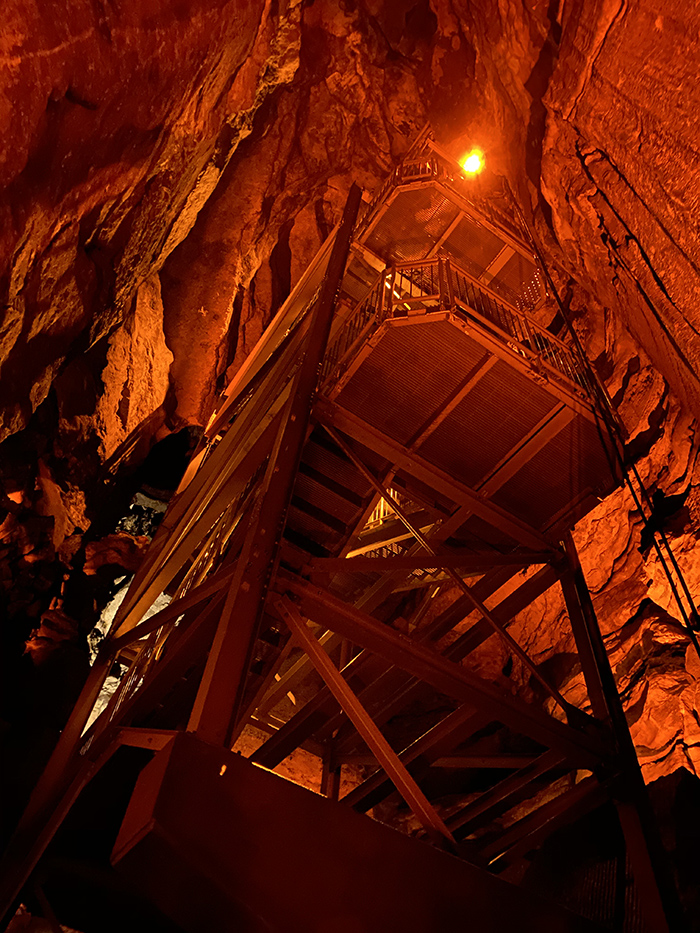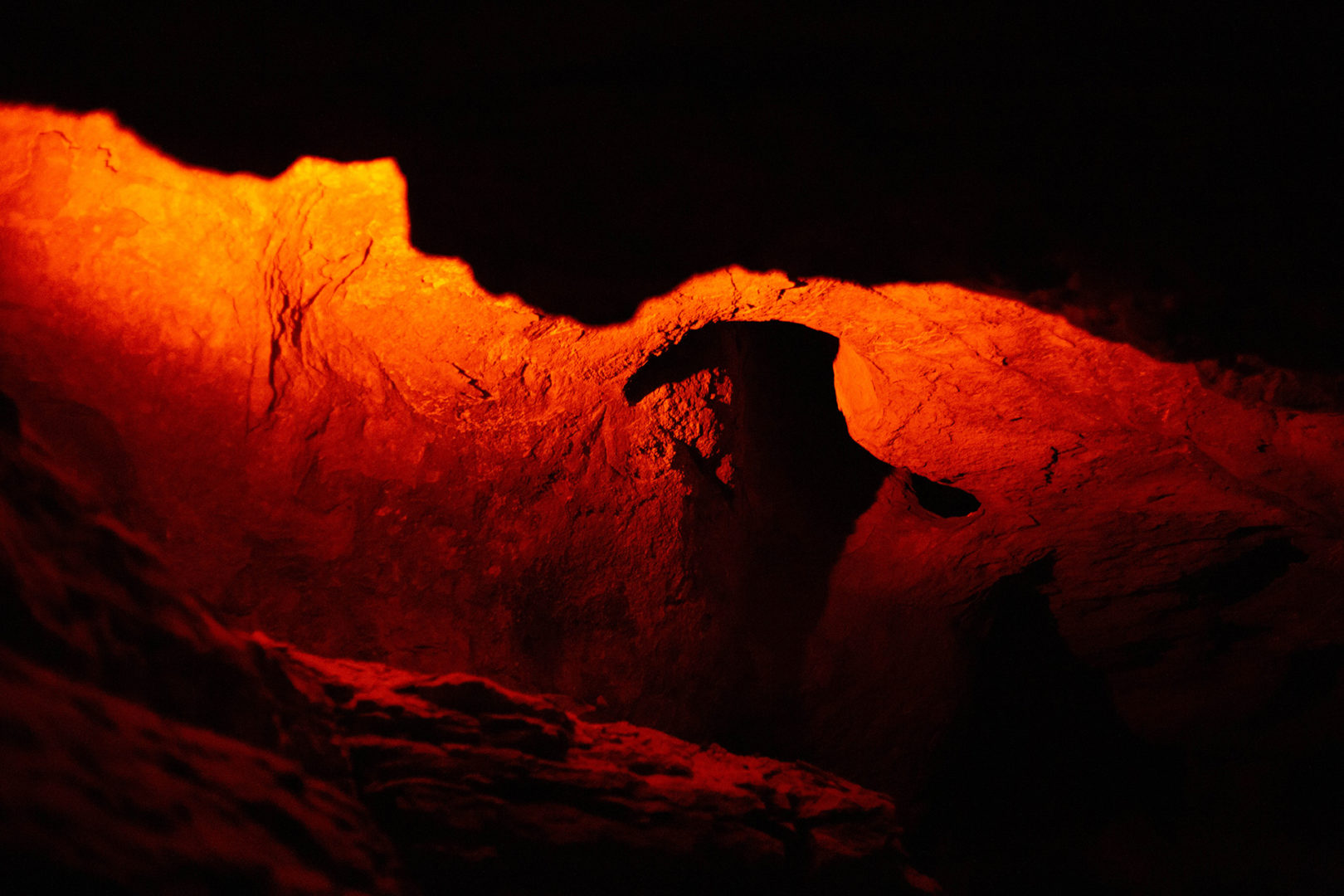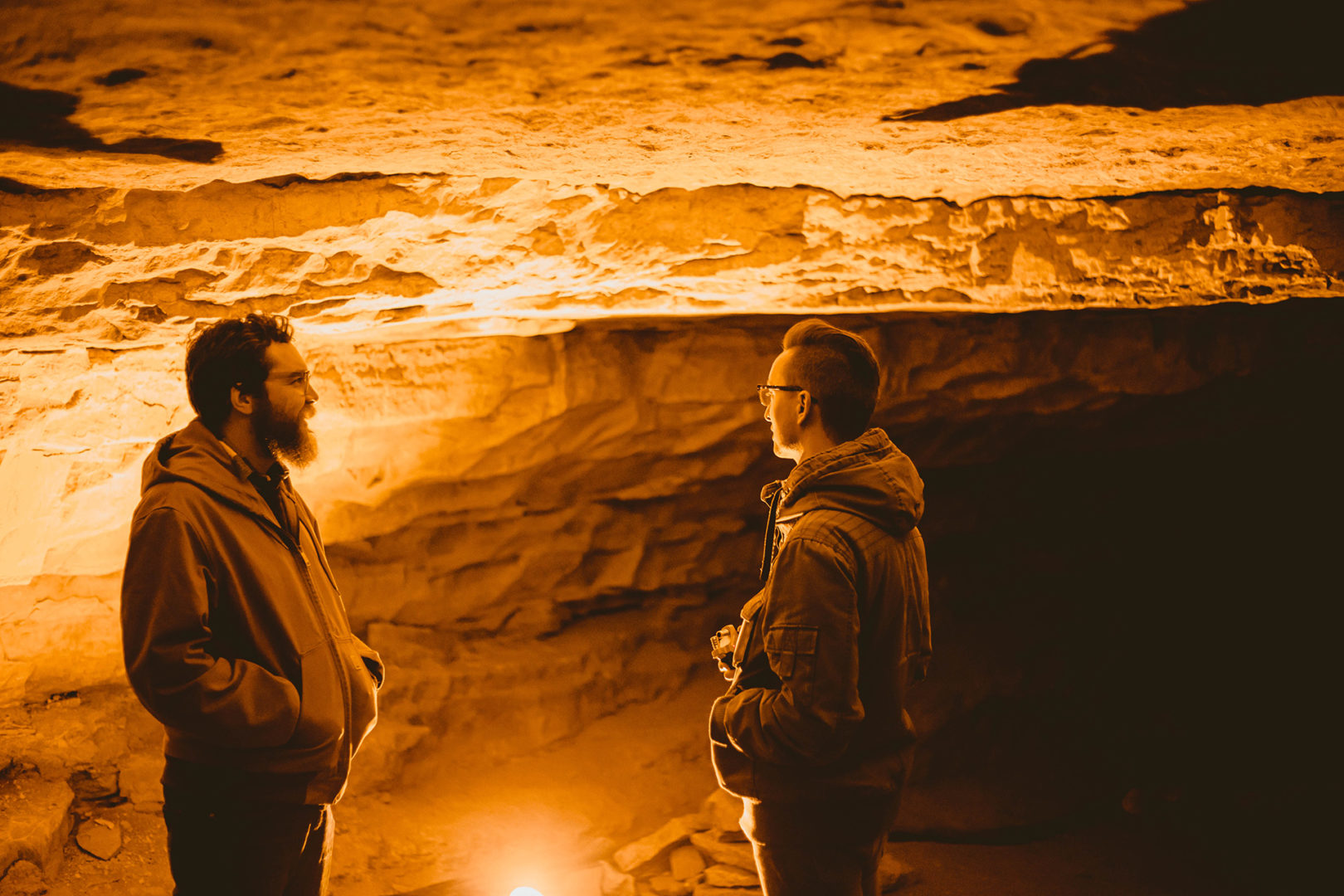We were in a maze of twisty little passages. A sporadically lit path gently repelled the perfect darkness all around. The surrounding void gave way, in passing, to hint at dozens of enticing tributaries; some only extended into shallow alcoves, but others undoubtedly breached into worlds heretofore unknown. It’s one thing to travel a path laid out for you as a semi-passive observer, but I imagine it’s quite another to chart the course through the murk toward a destination unknown.
The first thing that stood out to me about Mammoth Cave was, perhaps appropriately, the enormousness of it. Together with game developer and fellow Kentucky resident Jake Elliott, I descended a few dozen stairs into the gaping maw of the “historic entrance.” The ensuing passages varied in size and shape, but they all served to make me feel diminutive by comparison, like a benign parasite in the petrified guts of the Commonwealth. Many of the larger paths are referred to as “avenues” due to their impressive scale, which reminded me of Washington, DC’s barrel-vaulted metro system architecture—if it had been created by 10 million years of erosion. Still, at times I had to crouch and sidestep to accommodate the stony contours, though that sounded more comfortable than the Wild Cave tour, which requires visitors to actually crawl through crevices for the better part of three hours. All told, it’s a spectacular setting, full of mystery and rich with metaphor for an enterprising storyteller to indulge.
I had met Elliott in Mammoth Cave National Park’s visitor center 15 minutes before our guided tour was scheduled to begin. Elliott, along with Tamas Kemenczy and Ben Babbitt, make up Cardboard Computer, the team that had been creating the narrative adventure game Kentucky Route Zero for the past decade. The game launched with the first of five acts in 2013, and the initial plan was to release the remaining four over the following year. Kentucky Route Zero finally saw its full release on consoles and PC this past January, concluding the anomalous, 10-year-long development journey.
“We’ve been really lucky, really fortunate, whatever the mechanism has been, to have been able to work on something so idiosyncratic at our own pace for so long,” Elliot reflected. “Yeah, it’s unusual for sure.”
Later, over email, Kemenczy offered his own reflection on the game’s protracted development. “We’ve always had an outline from the beginning that tracked the overall shape of the story,” he wrote. “And pretty early on we knew that the duration of each act was going to vary in order to better divide the story into cohesive segments where each was able to focus on a particular theme or two.” That each act “varies” is perhaps an understatement, especially if you factor in the experimental nature of the between-act interlude segments.

Credit: Ashton Dawn for EGM
If you’re not familiar, Kentucky Route Zero is set in a magical realist version of Mammoth Cave and the surrounding region. It’s a text-heavy narrative adventure game that follows a delivery driver and a TV repairwoman as they travel in search of a location that may not physically exist. They collect more offbeat companions along the way, each motivated by their own personal reasons for joining this trek into the unknown. The quest that follows weaves through obsolete technology, geological marvels, dingy dive bars, mystic bureaucracy, and the fallout from financial downturn. “And also, the game is a tragedy, but I don’t think that necessarily means it’s a sad story or that it’s a story that has a negative view on human life,” Elliott said. “Because tragedy is pretty classically about human nobility.”
The map in Act I shows Interstate Highway 65 and other roadways laid out relatively accurately to their real-world bluegrass counterparts. “There are some distortions in the space [such as] a lot of different time periods happening at once,” Elliott said. But “[Kentucky] is a real place and all three of us always tried to respect it as a real place.” It’s the titular Zero, an underground highway (lowway?), defying all conventional mapping or prospects of “accuracy,” that serves as one of several of the game’s analogues for the Mammoth Cave System.
Perhaps the biggest influence on Kentucky Route Zero’s choice of setting was William Crowther’s Colossal Cave Adventure, originally released in 1976. Crowther, who also had a hand in developing the internet precursor ARPANET, drew inspiration from his own experiences as a caver. “The first game that I made when I was a kid (I was learning BASIC programming) was a total rip-off of Colossal Cave Adventure,” Elliot told me as we traversed one of Mammoth’s vast “avenues.” “It was going through a maze in caves and hiding your treasure from pirates.”
Colossal Cave Adventure, considered by many to be the first text adventure game, takes place in a section of Mammoth Cave called Bedquilt. There’s not much to look at in the original release of Colossal Cave Adventure beyond the words on the screen—a text adventure in the truest sense. Kentucky Route Zero’s stark text presentation, limited color palette, and sparsely detailed characters and backdrops cast a spotlight onto the writing itself, which harkens back to Colossal Cave Adventure’s pregraphical display. Besides, there’s just something about navigating an environment via text alone that nicely parallels the act of cave exploration, with its inherently limited visibility.

“We’ve been really lucky, really fortunate, whatever the mechanism has been, to have been able to work on something so idiosyncratic at our own pace for so long.”
Jake Elliott had been to Mammoth only once before our venture together but had spent considerable time with Colossal Cave Adventure. “I’ve been playing it since I was like five years old,” he recounted as we kept an eye out for low ceilings and other subterranean hazards. “My dad was a grad student at Carnegie Mellon in the ’80s, and we had a home terminal that could dial into the university computer and play some games. We had Colossal Cave Adventure and another one called Hunt the Wumpus—another text adventure game about being in a cave and hunting a monster.” Hunt the Wumpus offers a much more simplified version of cave exploration compared to Colossal’s detail-rich descriptions and intricate text command possibilities. “[Before Kentucky Route Zero,] Tamas and I worked on another project with a friend of ours named John Cates that was a kind of remix of [Colossal Cave Adventure], so [Mammoth] was really on our minds as an interesting setting.”
Act III of Kentucky Route Zero contains a section where the characters restore an old computer terminal inside a cave that then charges them with playing their own text adventure to find the answers they seek. It’s an intriguing bit of metafiction that plays, as the game so often does, with the already-blurry line that separates the real from the imagined. We paused for a moment to take some pictures where a cave wall was theatrically illuminated by a warm flood light that made the surface appear even more otherworldly than normal. “[Mammoth Cave] specifically feels like a fictional place to me first, and then like a real place kind of inspired by the fictional place, because it’s just been this video game setting in my game and these earlier games I played,” Elliot recalled. “So, this place still feels kind of unreal to me.”

Credit: Dan Solberg for EGM
That sense of unreality was a regular occurrence as we navigated the actual Mammoth Cave. For me, it was never greater than when we reached Mammoth Dome and the human-made stairwell tower built within. There’s something alien about most of the cave landscape, where nothing is squared and space is warped by the echoing darkness. The Mammoth Dome emphasizes this with dramatic lighting that makes it appear as some titanic Martian tomb. But there is also a massive block of steel steps that ascends up and out of sight. The juxtaposition of natural wonder and human engineering paints a more surreal scene than either would on their own. I did not expect to be so bowled over by a set of stairs in a national park, but I was reminded of how Kentucky Route Zero grounds its most uncanny moments in the banalities of human existence, and how much more resonant that makes them feel.
Prior to happening upon the Mammoth Dome, Elliott told me he sees the cave as “kind of like a second space, like a dream space or something that you can access.” The trajectory of Kentucky Route Zero is a meander, but not aimless; the player character in Act I, Conway, is tasked with making a delivery to an address supposedly located on the mysterious Zero. However, since the Zero cannot be reached through conventional means, you must venture into the depths of an old mining cave in search of an onramp of questionable corporeality. “A lot of meditation exercises involve visualizing entering a cave,” Elliott explained. “It’s an image we correlate to entering a surreal space that’s like an internal [or] psychological space.”
In the visitor center, there’s a bronze sculpture depicting the layout of a section of Mammoth Cave, and I was struck by just how neural the spindles of connecting and disconnecting passages appeared. There’s definitely an element of introspection and cerebral challenge for the characters in Kentucky Route Zero who embark on the Zero and are pushed to reconcile with their lots in life, but on top of that, the road/cave feels like it has a mind and will of its own. “It’s just under us and it keeps getting bigger, you know, it keeps growing.” We trekked forward to find such landmarks as the “Bottomless Pit” and “Tall Man’s Agony,” and Elliott went on to explain that “in the ’70s there was the Flint Ridge Cave System and the Mammoth Cave System, and they were like the two biggest cave systems. And then they found out they were the same cave system. So, there are these secret connections, and there’s something kind of like the subconscious about it.”
Likewise, over the course of the game, more characters join your party, each with their own motivations, but also connected to one another through an unspoken, implicit bond. “There’s an element of unknowable or unspeakable experiences we might have that we can’t put into words,” Elliott told me. “[Kentucky Route Zero] is trying to contextualize what is happening right now, either for [the characters in the game] or what’s happening in the world for us as something that has been a continual struggle between the ruling class and the rest of us that’s been going on for hundreds of years. For me that’s also understanding that this struggle started before I was born and will continue probably after I die.” What better place than a cave to set the stage for this acknowledgement of deep time?


“The unknown” is something I kept coming back to over the course of my conversation with Elliott. Kentucky Route Zero tightly revolves around confronting the unknown, within and without. How much cave is yet undiscovered in the Mammoth System? The driving force of the game’s plot is to find an address no one can give you directions to. Many of the characters you meet along the way are burdened by debts, unsure what life will look like in a month. “Are we going to make it?” might never be said outright, but it weighs heavy nonetheless. People search the cave for answers, but often have to make do with a reconciliation with the unknown.
At one point on the tour we are asked to shut off flashlights, phones, and anything else that might emit light, that we might experience the cave by lard-burning lamplight as early 19th century explorers did. We merely stood on a conveniently paved surface while our guide traipsed around on disarrayed boulders to demonstrate the difficulty of navigating with a limited sense of surroundings. Then the guide blew his candle out and the darkness was total. There were over 50 people on the tour, but all of a sudden that number felt insignificant. I lost not only the sense of where Jake or anyone else were, but also the sense of where I was. Obviously, I was still present, but in that moment I had a different sense of self—absent of visual recognition, but nonetheless physical.
When the lights came back on and we started moving again, Elliott shared an anecdote he’d heard about experimental composer John Cage. “John Cage had this story he’d tell about where he’d go into this anechoic chamber where it’s totally sound insulated, so sound barely even propagates,” Elliott began. “So, he went in there for a while and then he came out and said he could still hear these two sounds, one was this rumbling sound and the other was this whining sound and they told him one was his blood and also his nervous system.” Cage’s most well known work is probably 4’33”, comprised of 4 minutes and 33 seconds of silence, pushing listeners to pay attention to the sounds that happen in a space with the same rapt attention usually reserved for “music.”

In 2016, Cardboard Computer released a music video for a song from in-game character Junebug called “Static Between Stations.” It’s a gloomy bit of synth-pop with a refrain that goes “The static between stations / gives me relief now. / The space between places / it’s where I’m found.” Kentucky Route Zero is rich with liminal space and employs it to explore societal anxieties and the ephemera of the everyday, the conjunctions that get us from one place to the next but are less often examined than either end of a transition. The game lives in this in-between—a void of time compression and vulnerability translated into digital interactive fiction.
In fact, that music video was one of several ARG-like happenings that bridged the at times yearslong gaps between proper acts of the game. These interludes, performances, and other assorted media output expanded the scope of the Kentucky Route Zero project to blend the game world with ours. In one such instance, Kamenczy modified a couple telephones with microcontrollers to only dial the one number to call their fictional hotline for tours of the underground Echo River. They then conducted a livestreamed auction of the phones, including a musical performance by Babbitt and footage of the game. “And our press release for that thing was really cagey in the way we are about a lot of our work,” Elliott admitted. “It didn’t really explain that this was a videogame or anything, it just said it was an auction for this weird telephone that only dials one number.”
For the most part, this has been how Cardboard Computer has interacted with their public: sparse updates, obtuse events, and surprise announcements, all of which serve the mysterious tone of the game they are promoting. Or as Kemenczy put it simply, “we had to be cagey about KRZ to avoid spoilers!” In September 2018, the team also started a Patreon to help mitigate certain monthly expenses and also to test the waters of being more transparent with their players. “I think it’s changed the way it feels to make this game to a certain extent,” Babbitt told me over email. “It’s still such a new thing, but that’s been really enjoyable just to have more of an open dialogue with people who really enthusiastically support our process and what results from it.” Of course, just because the team started a Patreon doesn’t mean it’s given up on its cryptic social media presence—it’s just another option, one that considers the realities of game development.

As Elliott and I approached the exit to the cave, the chill returned. Outside it was in the 20s, but Mammoth Cave maintains a temperature of about 54 year-round. While there’s a certain comfort in that consistency, the bite of the cold was invigorating. I am eager to return to Mammoth Cave again and try a new path, but I was also excited to view the surface world with renewed perspective.
We stood at the bottom of the cave opening where we first entered, streams of water trickling over the immense archway onto the rocks beside our feet. Water built these caves over eons, and the best we can do is preserve and appreciate them. We often think of game development as happening in a kind of cave itself, with programmers and designers glued to computer screens as the planet continues to march in oblivious stride. “[For] all three of us, it’s been almost 10 years, and it’s been so much work this whole time—there haven’t really been slow periods,” Elliott told me. “It’s been having something block my vision for almost 10 years, so I think I’m ready to look at something else.” Even an experienced caver needs to surface sometime.
Header image and uncredited image: Ashton Dawn for EGM
Correction: An earlier version of this piece referred to a character in Kentucky Route Zero as “Connor.” The correct name is Conway.

Dan Solberg is an interdisciplinary artist, freelance writer/designer, and art educator, producing works in and around digital media. In 2018, he coordinated and designed the DED LED compilation project, preserving a set of videogame criticism from 50 contributing writers. You can follow him on Twitter @Dan_Solberg.